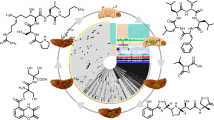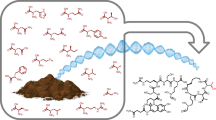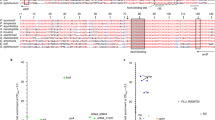Abstract
The production of natural product compound libraries has been observed in nature for different organisms such as bacteria, fungi and plants; however, little is known about the mechanisms generating such chemically diverse libraries. Here we report mechanisms leading to the biosynthesis of the chemically diverse rhabdopeptide/xenortide peptides (RXPs). They are exclusively present in entomopathogenic bacteria of the genera Photorhabdus and Xenorhabdus that live in symbiosis with nematodes delivering them to insect prey, which is killed and utilized for nutrition by both nematodes and bacteria. Chemical diversity of the biologically active RXPs results from a combination of iterative and flexible use of monomodular nonribosomal peptide synthetases including substrate promiscuity, enzyme cross-talk and enzyme stoichiometry as shown by in vivo and in vitro experiments. Together, this highlights several of nature's methods for diversification, or evolution, of natural products and sheds light on the biosynthesis of the bioactive RXPs.
This is a preview of subscription content, access via your institution
Access options
Subscribe to this journal
Receive 12 print issues and online access
$259.00 per year
only $21.58 per issue
Buy this article
- Purchase on Springer Link
- Instant access to full article PDF
Prices may be subject to local taxes which are calculated during checkout





Similar content being viewed by others
References
Bar-Even, A. et al. The moderately efficient enzyme: evolutionary and physicochemical trends shaping enzyme parameters. Biochemistry 50, 4402–4410 (2011).
Weng, J. K. & Noel, J. P. The remarkable pliability and promiscuity of specialized metabolism. Cold Spring Harb. Symp. Quant. Biol. 77, 309–320 (2012).
Fischbach, M. A. & Clardy, J. One pathway, many products. Nat. Chem. Biol. 3, 353–355 (2007).
Firn, R. D. & Jones, C. G. Natural products—a simple model to explain chemical diversity. Nat. Prod. Rep. 20, 382–391 (2003).
Weng, J.-K., Philippe, R. N. & Noel, J. P. The rise of chemodiversity in plants. Science 336, 1667–1670 (2012).
Tudzynski, B. Gibberellin biosynthesis in fungi: genes, enzymes, evolution, and impact on biotechnology. Appl. Microbiol. Biotechnol. 66, 597–611 (2004).
Ross, A. C. et al. Biosynthetic multitasking facilitates thalassospiramide structural diversity in marine bacteria. J. Am. Chem. Soc. 135, 1155–1162 (2013).
Donia, M. S., Ravel, J. & Schmidt, E. W. A global assembly line for cyanobactins. Nat. Chem. Biol. 4, 341–343 (2008).
Schröder, F. C. et al. Combinatorial chemistry in insects: a library of defensive macrocyclic polyamines. Science 281, 428–431 (1998).
Meyer, S. et al. Biochemical dissection of the natural diversification of microcystin provides lessons for synthetic biology of NRPS. Cell Chem. Biol. 23, 462–471 (2016).
Xu, Y. et al. Biosynthesis of the cyclooligomer depsipeptide beauvericin, a virulence factor of the entomopathogenic fungus Beauveria bassiana. Chem. Biol. 15, 898–907 (2008).
Sieber, S. A. & Marahiel, M. A. Molecular mechanisms underlying nonribosomal peptide synthesis: approaches to new antibiotics. Chem. Rev. 105, 715–738 (2005).
Wenzel, S. C., Meiser, P., Binz, T. M., Mahmud, T. & Müller, R. Nonribosomal peptide biosynthesis: point mutations and module skipping lead to chemical diversity. Angew. Chem. Int. Ed. 45, 2296–2301 (2006).
Juguet, M. et al. An iterative nonribosomal peptide synthetase assembles the pyrrole-amide antibiotic congocidine in Streptomyces ambofaciens. Chem. Biol. 16, 421–431 (2009).
Mootz, H. D., Schwarzer, D. & Marahiel, M. A. Ways of assembling complex natural products on modular nonribosomal peptide synthetases. ChemBioChem 3, 490–504 (2002).
Crawford, J. M., Portmann, C., Zhang, X., Roeffaers, M. B. J. & Clardy, J. Small molecule perimeter defense in entomopathogenic bacteria. Proc. Natl Acad. Sci. USA 109, 10821–10826 (2012).
Proschak, A. et al. Biosynthesis of the insecticidal xenocyloins in Xenorhabdus bovienii. ChemBioChem 15, 369–372 (2014).
Reimer, D. et al. Rhabdopeptides as insect-specific virulence factors from entomopathogenic bacteria. ChemBioChem 14, 1991–1997 (2013).
Reimer, D., Nollmann, F. I., Schultz, K., Kaiser, M. & Bode, H. B. Xenortide biosynthesis by entomopathogenic Xenorhabdus nematophila. J. Nat. Prod. 77, 1976–1980 (2014).
Bode, E. et al. Simple ‘on-demand’ production of bioactive natural products. ChemBioChem 16, 1115–1119 (2015).
Bode, H. B. et al. Determination of the absolute configuration of peptide natural products by using stable isotope labeling and mass spectrometry. Chem. Eur. J. 18, 2342–2348 (2012).
Fuchs, S. W., Grundmann, F., Kurz, M., Kaiser, M. & Bode, H. B. Fabclavines: bioactive peptide-polyketide-polyamino hybrids from Xenorhabdus. ChemBioChem 15, 512–516 (2014).
Vingadassalon, A. et al. Natural combinatorial biosynthesis involving two clusters for the synthesis of three pyrrolamides in Streptomyces netropsis. ACS Chem. Biol. 10, 601–610 (2015).
Mootz, H. D., Finking, R. & Marahiel, M. A. 4’-phosphopantetheine transfer in primary and secondary metabolism of Bacillus subtilis. J. Biol. Chem. 276, 37289–37298 (2001).
Moss, S. J., Martin, C. J. & Wilkinson, B. Loss of co-linearity by modular polyketide synthases: a mechanism for the evolution of chemical diversity. Nat. Prod. Rep. 21, 575–593 (2004).
Olivera, B. M. et al. Diversity of Conus neuropeptides. Science 249, 257–263 (1990).
Yamanaka, K., Maruyama, C., Takagi, H. & Hamano, Y. ε-Poly-L-lysine dispersity is controlled by a highly unusual nonribosomal peptide synthetase. Nat. Chem. Biol. 4, 766–772 (2008).
Maruyama, C. et al. A stand-alone adenylation domain forms amide bonds in streptothricin biosynthesis. Nat. Chem. Biol. 8, 791–797 (2012).
Schroeder, F. C. et al. Polyazamacrolides from ladybird beetles: ring-size selective oligomerization. Proc. Natl Acad. Sci. USA 95, 13387–13391 (1998).
Degenkolb, T. et al. The production of multiple small peptaibol families by single 14-module Peptide synthetases in Trichoderma/Hypocrea. Chem. Biodivers. 9, 499–535 (2012).
Tokuriki, N. & Tawfik, D. S. Protein dynamism and evolvability. Science 324, 203–207 (2009).
Blenau, W. & Baumann, A. Molecular and pharmacological properties of insect biogenic amine receptors: lessons from Drosophila melanogaster and Apis mellifera. Arch. Insect Biochem. Physiol. 48, 13–38 (2001).
Koeberle, A. & Werz, O. Multi-target approach for natural products in inflammation. Drug Discov. Today 19, 1871–1882 (2014).
Mehta, K. C., Dargad, R. R., Borade, D. M. & Swami, O. C. Burden of antibiotic resistance in common infectious diseases: role of antibiotic combination therapy. J. Clin. Diagn. Res. 8, ME05–ME08 (2014).
Fischbach, M. A. Combination therapies for combating antimicrobial resistance. Curr. Opin. Microbiol. 14, 519–523 (2011).
Zhou, Q. et al. Xentrivalpeptides A–Q: depsipeptide diversification in Xenorhabdus. J. Nat. Prod. 75, 1717–1722 (2012).
Nollmann, F. I. et al. Insect-specific production of new GameXPeptides in Photorhabdus luminescens TTO1, widespread natural products in entomopathogenic bacteria. ChemBioChem 16, 205–208 (2015).
Balunas, M. J. et al. Dragonamide E, a modified linear lipopeptide from Lyngbya majuscula with antileishmanial activity. J. Nat. Prod. 73, 60–66 (2010).
Sanchez, L. M. et al. Almiramides A−C: discovery and development of a new class of leishmaniasis lead compounds. J. Med. Chem. 53, 4187–4197 (2010).
Simmons, T. L. et al. Viridamides A and B, lipodepsipeptides with antiprotozoal activity from the marine cyanobacterium Oscillatoria nigro-viridis. J. Nat. Prod. 71, 1544–1550 (2008).
Lang, G. et al. Pterulamides I−VI, linear peptides from a Malaysian Pterula sp. J. Nat. Prod. 69, 1389–1393 (2006).
Sambrook, J., Fritsch, E. F. & Maniatis, T. Molecular Cloning: A Laboratory Manual (Cold Spring Harbor, 1989).
Hacker, C., Glinski, M., Hornbogen, T., Doller, A. & Zocher, R. Mutational analysis of the N-methyltransferase domain of the multifunctional enzyme enniatin synthetase. J. Biol. Chem. 275, 30826–30832 (2000).
Acknowledgements
This work was supported by an ERC Starting Grant to H.B.B. (grant agreement no. 311477). The authors are grateful to Daniela Reimer for her pioneering work on rhabdopeptide biosynthesis and the identification of the first RXP-BGC. Additionally, M.K. and H.B.B. were supported by the European Community's Seventh Framework Program (FP7/2007–2013) under grant agreement no. 602773.
Author information
Authors and Affiliations
Contributions
X.C. and H.B.B. planned the experiments and wrote the paper, all experiments were performed by X.C. except protein expression, quantification and in vitro experiments performed by S.N., chemical synthesis of RXPs performed by F.W. and bioactivity testing performed by M.K., I.B. and R.F. All authors discussed the results and commented on the manuscript.
Corresponding author
Ethics declarations
Competing interests
The authors declare no competing financial interests.
Supplementary information
Supplementary information
Supplementary information (PDF 3649 kb)
Supplementary information
Supplementary information (XLSX 36 kb)
Supplementary information
Supplementary information (XLSX 21 kb)
Supplementary information
Supplementary information (XLSX 33 kb)
Supplementary information
Supplementary information (XLSX 23 kb)
Supplementary information
Supplementary information (XLSX 22 kb)
Rights and permissions
About this article
Cite this article
Cai, X., Nowak, S., Wesche, F. et al. Entomopathogenic bacteria use multiple mechanisms for bioactive peptide library design. Nature Chem 9, 379–386 (2017). https://doi.org/10.1038/nchem.2671
Received:
Accepted:
Published:
Issue Date:
DOI: https://doi.org/10.1038/nchem.2671
This article is cited by
-
Genetic toolbox for Photorhabdus and Xenorhabdus: pSEVA based heterologous expression systems and CRISPR/Cpf1 based genome editing for rapid natural product profiling
Microbial Cell Factories (2024)
-
Biosynthesis and engineering of the nonribosomal peptides with a C-terminal putrescine
Nature Communications (2023)
-
Global analysis of biosynthetic gene clusters reveals conserved and unique natural products in entomopathogenic nematode-symbiotic bacteria
Nature Chemistry (2022)
-
Natural products from Photorhabdus and Xenorhabdus: mechanisms and impacts
Applied Microbiology and Biotechnology (2022)
-
Integrating genomics and metabolomics for scalable non-ribosomal peptide discovery
Nature Communications (2021)



